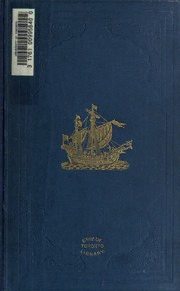
The texts and versions of John de Plano Carpini and William de Rubruquis, as printed for the first time by Hakluyt in 1598, together with some shorter pieces; edited by C. Raymond Beazley PDF
Preview The texts and versions of John de Plano Carpini and William de Rubruquis, as printed for the first time by Hakluyt in 1598, together with some shorter pieces; edited by C. Raymond Beazley
ih. \jU^tL^ At.U-t-»J ON A HITHERTO UNEXAMINED MANU- SCRIPT OF JOHN DE PLANO CARPINI. By C. Eaymond Beazley, M.A. {Frmn ' The Geographical Journal' for December.) While working lately in the Library of Corpus Cliristi College, Cam- bridge, I came upon a manuscript (No. 181, pp. 279-321) hitherto unknown except by the bare mention of its title in Nasmith's and other catalogues, which seems to have a distinct interest and value. It con- tains, in the most complete form, the text of John de Piano Carpini's account of the Mongols, and of his journey to the Great Khan's court (a.d. 1245-7). The last chapter of Carpini's Historia Mongalorum has hitherto been supposed to exist only in the Leyden manuscript known as "Petau," from its old possessor Paul Petavius; and as this chapter is the record of Carpini's journey to Mongolia and back, it is more valuable than any of the eight that precede it. Now, the whole of this final chapter is to be found in the Corpus manuscript referred to, whose value was wholly unknown to the eminentFrench scholar M. d'Avezac, when he prepared his remarkable edition of Carpini for volume iv. of the Paris Geographical Society's Becueil de Voyages et deMemoirespuhlie par la Societe de Geographie, 1839. Its worth and content were equally unknown to Thomas Wright,whocollatedina strangely casual manner the London manuscript of Carpini (B. Mus., Eeg. 13 A. XIV.) for this edition ofthe Societe de Geographie. The aforesaid edition of 1839 is, of course, still the standard, and, indeed, the only recognizable one ofthis great Franciscan traveller, for the truncated and corrupt text printed by Hakluyt,and generally accepted till1839,is unworthyofcomparison with that exhibited in the manuscripts of "Petau" and "Corpus" and in the Paris text. " 2 ON A HITHERTO UNEXAMINED MANUSCRIPT It may be added that the Corpus manuscript contains in several places fuller and more satisfactory readings even than " Petau." M. d'Avezac, no doubt guided by the information orwant ofinformationhe received from England about Carpini manuscripts, evidently considered that another manuscript of the Historia Mongalorum existed in Cam- bridge,viz. No.61 (orratheroneinNo. 61) inthecollectionof "Bennet College; but this is theverysamething as one in No.181 inthepresent numbering of the Corpus collection, 61 being the number in Edward Bernard's catalogue, now superseded by181 in Nasmith's. It is strange that this simple verification seems never to have been made hitherto. According to Bernard,moreover(Gatalogilibrorum mannscriptorumAngliae et Hibemiae, 1697; partiii.,p. 133,no. 1337,referring to 61 in the list of codices manuscnpti CollegiiS.Benedicti,and to thethirditem in the sixty- first manuscript), the Carpini manuscript, called Historia Monogallorwn sive Tartarorum Pr. Omnibus fidelibus, is the third piece in the volume, the Eubruquis manuscript being reckoned as the fifth. This reckoning is.reproduced by d'Avezac {Recueil, as quoted above, p. 448), the great Paris geographer evidently considering that this manuscript of Carpini was onlycatalogued in Bernard. But, as a matteroffact,the Rubruquis text follows Carpini here without any interval whatever, and the two really form the eighth and ninth items in the volume. It is also note- worthy that Nasmith (Catalogue librorum manuscriptorum quos Coll. Corp. Christ,et B. M. Virg. in Acad. Cantab, legavit Matth.Parker; 1777; in the general heading to clxxxi., which is described as seculo xv. scriptus) speaks as if all the pieces were of the fifteenth century, whereas they are ofdistinctly varying date,and the two with which we are specially concerned (Carpini and Rubruquis) cannot possibly be later than the early fourteenth century, and were probably written before 1300. As Carpini is in the first rank of mediaeval explorers, standing but little below Marco Polo, the discovery of another manuscript of his complete text, preferable in some points even to the best hitherto collated, may not be without interest. The writing is of the latter part ofthe thirteenth century,or earlierpart ofthefourteenth(c. 1260- 1320), and is in the same hand as the manuscript of Eubruquis known as D, which immediately follows, and the extracts from ^Ethicus which end the volume; the lines are long, running over the whole breadth of the page. The additions which*' Petau" makestothetextofthe earlier chapters (De moribus Tartarorum, etc.), a^d which are in several cases direct and avowed additions of the author revising his work, appear in " Corpus," e.g. the passagehaecautemquse superius scripta sunt . . . possi- debit, following the words adversarii manifesti, with which all but these twomanuscriptsend. Thispassagecontainsanauthor's"personalnote " to the efi'ect that in the militarydetailshe has just given ofthe Mongol army, and of the best manner of resisting that army, he has no inten- tion oftrespassing on soldiers' ground,but onlyoffurnishing occasionem OF JOHN DE PLANO CARPINI. 3 et materiam cogitandi. The whole bears the most distinct evidence of belonging to a second revised and improved edition. The Corpus manuscript of Carpini is not only (with Petau) the fullest, it is also the oldest, text of the Hiatoria Mongalorum, and it seems to have been written at latest within seventy years of the traveller's return from Central Asia, and probably (as Michel and Wright consider of the Kubruqnis manuscript in the same hand,which follows)even before the end of the thirteenth century. It is, therefore, to all appearance a few years older than "Petau;" and the years 1260-1320 (above referred to) may be taken as an outside, 1270-1290 as an inside, date for its transcription. PRINTED BY WILLIAM CLOWBS AND SONS, LIMITED, LONDON AND BECCLES. r THE TEXTS AND VERSIONS OF JOHN DE PLANO CARPINI AND WILLIAM DE RUBRUQUIS
